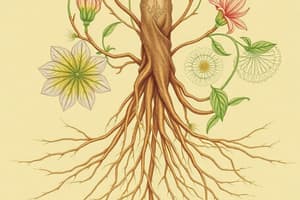Podcast
Questions and Answers
Explain why Bryophytes are often referred to as the 'amphibians of the plant kingdom.'
Explain why Bryophytes are often referred to as the 'amphibians of the plant kingdom.'
Bryophytes need water to reproduce, even though they live on land.
If a plant exhibits pinnately compound leaves, explain how this leaf structure might be advantageous in specific environmental conditions.
If a plant exhibits pinnately compound leaves, explain how this leaf structure might be advantageous in specific environmental conditions.
The leaf is less resistant to wind and can reduce water loss.
Explain how the rules of binomial nomenclature contribute to the understanding and classification of organisms.
Explain how the rules of binomial nomenclature contribute to the understanding and classification of organisms.
Binomial nomenclature provides a standardized, universal naming system, ensuring each organism has a unique scientific name, facilitating clear communication in biology.
Describe how the structural adaptations of a xerophytic pteridophyte enable it to survive in dry environments.
Describe how the structural adaptations of a xerophytic pteridophyte enable it to survive in dry environments.
Differentiate between heterochromatin and euchromatin in terms of their structure and transcriptional activity.
Differentiate between heterochromatin and euchromatin in terms of their structure and transcriptional activity.
Explain how a contractile vacuole in Paramecium contributes to its survival in a freshwater environment.
Explain how a contractile vacuole in Paramecium contributes to its survival in a freshwater environment.
Describe how the Malpighian tubules in cockroaches facilitate excretion, mentioning their location and mechanism of action.
Describe how the Malpighian tubules in cockroaches facilitate excretion, mentioning their location and mechanism of action.
Considering the structure of a typical dicot stem, explain how the arrangement of vascular bundles contributes to its strength and flexibility.
Considering the structure of a typical dicot stem, explain how the arrangement of vascular bundles contributes to its strength and flexibility.
If a botanist discovers a new plant species lacking chlorophyll, what can they infer about its mode of nutrition and ecological role?
If a botanist discovers a new plant species lacking chlorophyll, what can they infer about its mode of nutrition and ecological role?
Explain how the structure of squamous epithelium relates to its function in the body, providing specific examples of where this tissue is found.
Explain how the structure of squamous epithelium relates to its function in the body, providing specific examples of where this tissue is found.
Flashcards
Brown Algae
Brown Algae
Photosynthetic protists containing chlorophyll a and fucoxanthin, giving them a brown color; include kelp forests and Sargassum.
Pteridophytes
Pteridophytes
Plants that have vascular tissue but reproduce via spores, not seeds; examples include ferns, horsetails, and clubmosses.
Sac Fungi (Ascomycetes)
Sac Fungi (Ascomycetes)
A group of fungi characterized by producing spores in a sac-like structure called an ascus.
Cell Cycle
Cell Cycle
Signup and view all the flashcards
Epithelium (Tissue)
Epithelium (Tissue)
Signup and view all the flashcards
Microvilli
Microvilli
Signup and view all the flashcards
Malpighian Tubules
Malpighian Tubules
Signup and view all the flashcards
Ethology
Ethology
Signup and view all the flashcards
Meiosis
Meiosis
Signup and view all the flashcards
Vertebral Column
Vertebral Column
Signup and view all the flashcards
Study Notes
Botany Questions
- Brown algae examples include Fucus and Laminaria.
- The stem's function is to support, transport, and sometimes store nutrients.
- Anabolism is the set of metabolic processes that construct molecules from smaller units.
- Phycomycetes examples include Mucor and Rhizopus.
- Examples of Eubacteria include Escherichia coli and Bacillus subtilis.
- The essential flower whorls are calyx, corolla, androecium, and gynoecium.
- Meiosis is cell division that results in four daughter cells each with half the number of chromosomes of the parent cell.
- An example of a thorn is Duranta.
- An example of a sucking root is Cuscuta.
- Tendrils function in providing support by twining around objects.
- Rose is an example of a pinnately compound leaf.
- The scientific name of a sunflower is Helianthus annuus.
- Varieties of sac fungi include Aspergillus and Penicillium.
- The term meiosis was coined by Farmer and Moore.
- The three domains of life are Archaea, Bacteria, and Eukarya.
- An aquatic Pteridophyte is Azolla, and a xerophytic Pteridophyte is Selaginella.
- Lycopodium is an example of club fungi.
Short Notes
- Useful fungi include edible mushrooms, yeasts for baking and brewing, and sources of antibiotics.
- Plant and animal specimens are kept in transparent jars with formalin to preserve them.
- Lamina is the blade of a leaf; Epipodium is an outgrowth on the ovary in some flowers.
- DNA barcoding applications include species identification, biodiversity assessment, and tracing food origins.
- It is about Metaphase, Anaphase (stages of mitosis/meiosis).
- Rules of Binomial Nomenclature is about genus and species names are written in Latin, genus is capitalized, and species is in lowercase, the entire name is italicized or underlined.
- It is about the Paramoecium diagram.
- Rhizoids of Bryophytes are root-like structures that anchor the plant and absorb water and nutrients.
- Pteridophytes are known as vascular cryptogams because they have vascular tissues but do not produce seeds.
- Bryophytes are called amphibians of the plant kingdom because they need water for reproduction, though they live on land.
- A fusiform root is a root that is thick in the middle and tapers towards both ends.
- Bulbils are small bulb-like structures that can develop into new plants.
- Cuscuta depends entirely on the host plant because it lacks chlorophyll and cannot perform photosynthesis.
Animal Tissue
- Microvilli function to increase the surface area for absorption.
- A tissue is a group of similar cells performing a specific function.
- Squamous epithelium functions in diffusion and filtration.
- Intercalated discs are found in the cardiac muscle.
- Squamous epithelium (a single layer of flattened cells).
- It is about the description of position, structure, and function.
- It is about the description of position, structure, and function.
- It is about the structure description.
Human Nutrition
- Digestion is the breakdown of food into smaller molecules for absorption.
- Dentition pertains to the arrangement and type of teeth in an organism.
- Nutrition is the process of obtaining nutrients necessary for health and growth.
- It is about the short notes on the Stomach.
- Nutritional disorders (Kwashiorkor is a protein deficiency disease).
- Position and function of salivary glands (Secrete saliva, which contains enzymes to initiate digestion).
- Digestion in mouth cavity (Process starts with saliva breaking down carbohydrates).
- Human Digestive System (Mouth, esophagus, stomach, small intestine, large intestine, rectum, anus).
Excretion and Osmoregulation
- It is about Excretion, and osmoregulation.
- The nephron is the structural and functional unit of the kidney.
- Ammonotelism is the excretion of nitrogen in the form of ammonia.
- Excretion is the process of removing metabolic waste from the body.
- It is about Ureotelism- excrete urea.
- It is about the T.S. of Skin with diagram.
- Match the Columns.
- Explain the excretory system in human beings with a well-labelled diagram.
- Draw a labelled diagram of the kidney.
Angiosperms and Viruses
- Roots are for anchorage and absorption, stems are for support and transport.
- Angiosperms characteristics include flowers, fruits, and seeds enclosed in an ovary.
- Algae characteristics include aquatic habitat, simple structure, and photosynthetic ability.
- Kingdom plantae classification: algae, bryophytes, pteridophytes, gymnosperms, angiosperms.
- Viruses: helical, icosahedral, enveloped, complex.
- Importance of Botanical Garden: conservation, education, research, recreation.
- Epiphytic roots absorb moisture from the air; stilt roots provide support.
Plant Anatomy
- About description of Funaria and Spirogyra.
- Racemose inflorescence has flowers arranged along an axis, cymose has a main flower that blooms first.
- Characteristics of Ascomycetes include asci-containing spores and septate hyphae.
- Typical fruit structure: pericarp, seed, and sometimes remnants of flower parts.
- Flower structure: sepals, petals, stamens, pistil.
- A cell cycle diagram include interphase, prophase, metaphase, anaphase, telophase, and cytokinesis.
- Leaf: lamina, petiole, veins, and stipules.
Animal Kingdom
- Phylum Mollusca examples include snails, clams, and squids.
- A blind sac body plan has a single opening for ingestion and egestion.
- Phylum Arthropoda examples include insects, spiders, and crustaceans.
- Sycon diagram.
- Mammal class.
- Arthropoda economic importance includes pollination, food, and disease transmission.
- Match the Following.
- Salient features of phylum Echinodermata include a water vascular system and radial symmetry.
- Characteres of phylum Mollusca include a soft body and a mantle.
Skeleton and Movement
- Sternum parts include the manubrium, body, and xiphoid process.
- Ethology is the study of animal behavior.
- The hip joint is a ball and socket joint.
- Synovial joint diagram.
- Human bone.
- Locomotion refers to the movement of an organism.
- Bone function is to provide support, protect organs, and enable movement.
- Vertebral column.
Cell Structure and Organization
- A cell is the basic structural and functional unit of living organisms.
- Heterochromatin is tightly packed DNA, typically inactive.
- A eukaryotic cell has a nucleus and other membrane-bound organelles.
- Nucleus.
- Endoplasmic reticulum.
- Mitochondria.
Invertebrate Anatomy
- It is about Cockroach Study the Animal type.
- Cockroach body divisions: head, thorax, and abdomen.
- Cockroach Heart chambers.
- It is about Salivary Glands of Cockroach.
- Cockroach sistamic Position.
- Digestive system diagram of Cockroach.
- Nervous system diagram of Cockroach.
Studying That Suits You
Use AI to generate personalized quizzes and flashcards to suit your learning preferences.




